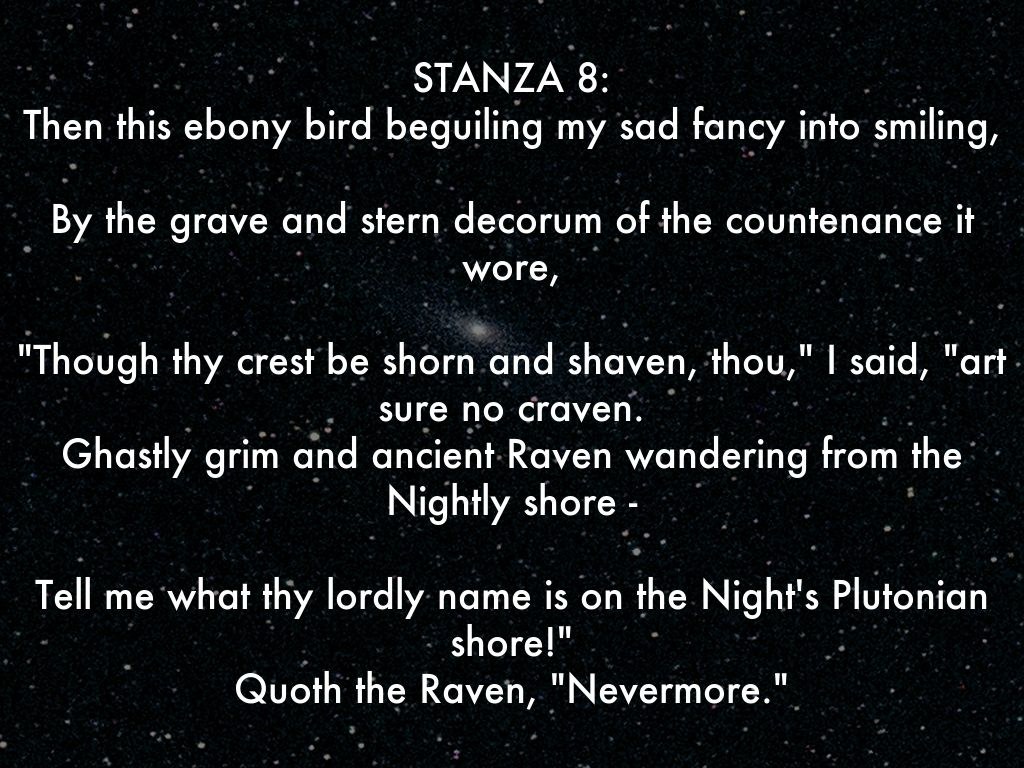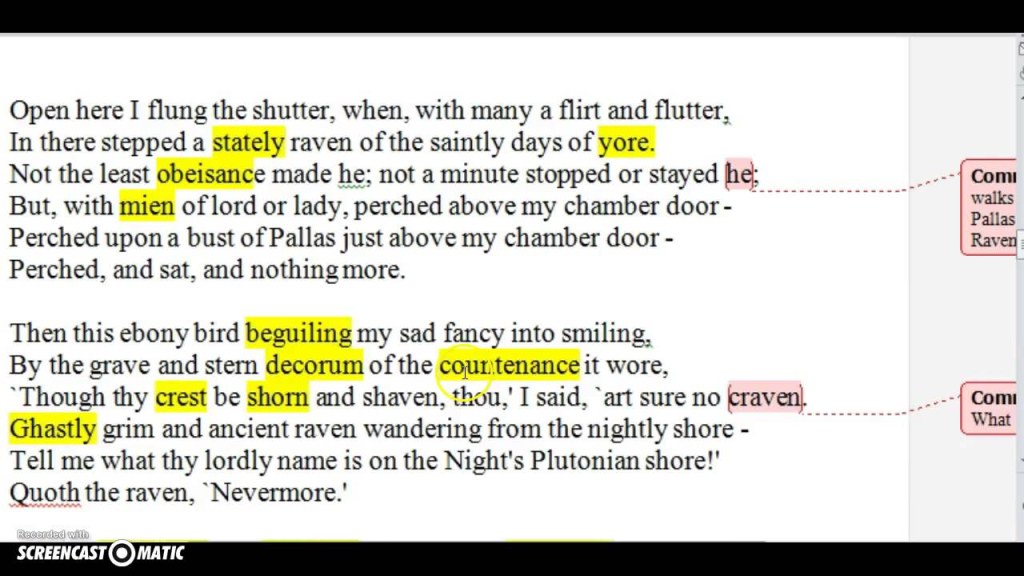Unlocking The Raven’s Secrets: An In-Depth Stanza-by-Stanza Analysis With Actionable Insights!
The Raven Analysis Stanza by Stanza
Introduction
Greetings, Raven Enthusiasts! In this article, we will delve into a detailed analysis of Edgar Allan Poe’s famous poem The Raven stanza by stanza. This haunting and mysterious poem has captivated readers for generations with its dark themes and vivid imagery. Join us as we unravel the deeper meanings behind each stanza, shedding light on the symbolism and emotions portrayed by Poe. Prepare to embark on a journey through the depths of despair and melancholy as we explore The Raven in all its glory.
3 Picture Gallery: Unlocking The Raven’s Secrets: An In-Depth Stanza-by-Stanza Analysis With Actionable Insights!



Overview of The Raven
Before we dive into the stanza-by-stanza analysis, let’s provide a brief overview of The Raven for those who are unfamiliar with this renowned poem. Published in 1845, it tells the story of a lonely man who is visited by a talking raven in the middle of the night. As the man descends into madness, the raven becomes a chilling symbol of his grief and despair. Now, let’s examine each stanza in detail to uncover the deeper meanings hidden within.
Stanza 1: The Setting and the Narrator’s State of Mind

Image Source: haikudeck.com
In the first stanza, we are introduced to a dark and gloomy setting, with the narrator sitting alone in his chamber on a bleak December night. The mention of forgotten lore and many a quaint and curious volume of forgotten knowledge suggests that the narrator is a scholar or an intellectual. However, his melancholic state of mind foreshadows the sorrowful journey that lies ahead.
Stanza 2: The Arrival of the Raven
The second stanza marks the arrival of the raven, tapping at the narrator’s chamber door. The repetition of the word nevermore by the raven echoes the narrator’s despair and serves as a constant reminder of his lost love, Lenore. The raven’s presence intensifies the narrator’s feelings of grief and hopelessness, as he desperately seeks solace in the bird’s wisdom.
Stanza 3: The Narrator’s Desperation

Image Source: cloudfront.net
As the poem progresses to the third stanza, the narrator’s desperation becomes more evident. He implores the raven to reveal his fate and whether he will be reunited with Lenore in the afterlife. The raven’s response of nevermore only deepens the narrator’s torment, as he realizes that his hopes and desires are futile.
Stanza 4: The Narrator’s Unsettling Reflections
The fourth stanza reflects the narrator’s descent into madness as he begins to question his own sanity. He sees the raven as a prophet of doom and wonders if it was sent by a higher power to torment him. The repetition of the word nevermore intensifies the sense of unease and further erodes the narrator’s fragile mental state.
Stanza 5: The Narrator’s Emotional Turmoil

Image Source: ytimg.com
In the fifth stanza, the narrator’s emotional turmoil reaches its peak. He becomes increasingly agitated and demands that the raven leave his chamber. However, the raven remains perched on the bust of Pallas, a symbol of wisdom, further fueling the narrator’s frustration and despair.
Stanza 6: The Narrator’s Final Descent
The final stanza marks the narrator’s complete surrender to his grief and madness. He resigns himself to the fact that his soul will be trapped in the shadow of the raven forever. The poem ends with a sense of hopelessness and a haunting reminder of the narrator’s eternal torment.
What is the significance of The Raven?
🔍 The Raven holds great significance in the realm of literature and has become one of Poe’s most famous works. It is a masterpiece of Gothic poetry, exploring themes of grief, loss, and the fragility of the human mind. The poem’s dark and haunting atmosphere, coupled with its vivid imagery, creates a lasting impression on readers.
Who is the narrator in The Raven?
🔍 The narrator in The Raven is an unnamed man who is mourning the loss of his beloved, Lenore. He is depicted as a lonely and tormented soul, haunted by his memories and consumed by grief. The narrator’s descent into madness throughout the poem adds to the overall sense of melancholy and despair.
When was The Raven written?
🔍 Edgar Allan Poe wrote The Raven in 1844 and it was first published in 1845. The poem quickly gained popularity and cemented Poe’s reputation as a master of macabre and psychological horror.
Where does The Raven take place?
🔍 The Raven takes place in the narrator’s chamber on a dreary December night. The setting adds to the overall gloomy and somber atmosphere of the poem, reflecting the narrator’s state of mind.
Why is The Raven significant in literature?
🔍 The Raven is significant in literature for its exploration of complex emotions and its use of symbolism. It delves into themes of grief and madness, showcasing the fragility of the human psyche. The poem’s lyrical style and haunting imagery have made it a literary classic that continues to captivate readers to this day.
How does The Raven impact readers?
🔍 The Raven has a profound impact on readers, evoking strong emotions and provoking deep introspection. Its themes of loss and despair resonate with individuals who have experienced grief, while its exploration of the human mind’s fragile nature offers insights into the complexities of the human condition.
Advantages and Disadvantages of Analyzing The Raven Stanza by Stanza
🔍 Analyzing The Raven stanza by stanza offers several advantages in understanding the poem’s deeper meanings. It allows readers to unravel the intricate symbolism and thematic elements woven throughout each section, providing a comprehensive interpretation. However, this method of analysis may also lead to over-analysis and the risk of losing sight of the poem’s overall impact and emotional resonance.
Advantages of Analyzing The Raven Stanza by Stanza
🔍 One advantage of analyzing The Raven stanza by stanza is the ability to focus on the nuances and symbolism present in each section. This approach allows for a more in-depth exploration of the poem’s themes and enhances the reader’s understanding of the narrator’s descent into madness.
Disadvantages of Analyzing The Raven Stanza by Stanza
🔍 On the other hand, analyzing The Raven stanza by stanza may result in an overly fragmented interpretation, potentially missing the poem’s overall impact. This method of analysis may also lead to a tendency to over-analyze every element, diluting the emotional power of the work.
Frequently Asked Questions About The Raven Analysis Stanza by Stanza
1. Q: What is the main theme of The Raven?
A: The main theme of The Raven is grief and the human mind’s fragility in the face of loss. It explores the overwhelming emotions experienced by the narrator as he mourns the loss of his beloved Lenore.
2. Q: What does the raven symbolize in the poem?
A: The raven symbolizes the narrator’s grief and impending doom. It serves as a constant reminder of his loss, tormenting him with its repetition of the word nevermore.
3. Q: Why is The Raven considered a Gothic poem?
A: The Raven is considered a Gothic poem due to its dark and eerie setting, supernatural elements, and exploration of the macabre. It embodies the characteristics of Gothic literature, evoking a sense of mystery and melancholy.
4. Q: What is the significance of the repetition of nevermore?
A: The repetition of nevermore by the raven serves to intensify the narrator’s grief and despair. It highlights the futility of his hopes and desires, emphasizing the eternal nature of his torment.
5. Q: How does The Raven reflect Edgar Allan Poe’s personal struggles?
A: Edgar Allan Poe’s personal struggles with loss and depression are reflected in The Raven. The poem explores themes that resonated deeply with Poe, showcasing his own experiences with grief and his fascination with the human psyche.
Conclusion
In conclusion, The Raven is a haunting and powerful poem that continues to captivate readers with its exploration of grief, loss, and madness. Through our stanza-by-stanza analysis, we have uncovered the deeper meanings and symbolism present in each section, shedding light on the narrator’s descent into despair. Whether you are a literature enthusiast or a casual reader, The Raven offers a profound journey into the depths of the human psyche, leaving an indelible mark on all who dare to delve into its melancholic beauty.
Now, it’s your turn to immerse yourself in the world of The Raven and discover the secrets hidden within each stanza. Happy reading, Cool Peoples!
Final Remarks
Disclaimer: The analysis presented in this article is subjective and open to interpretation. The beauty of The Raven lies in its ability to evoke diverse emotions and resonate with readers in unique ways. The true meaning of the poem may vary from person to person, inviting personal introspection and reflection. We encourage you to explore The Raven with an open mind and discover your own insights along the way.
This post topic: Raven



